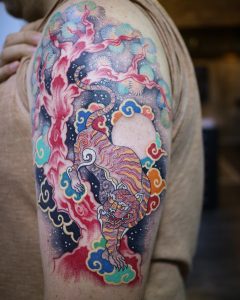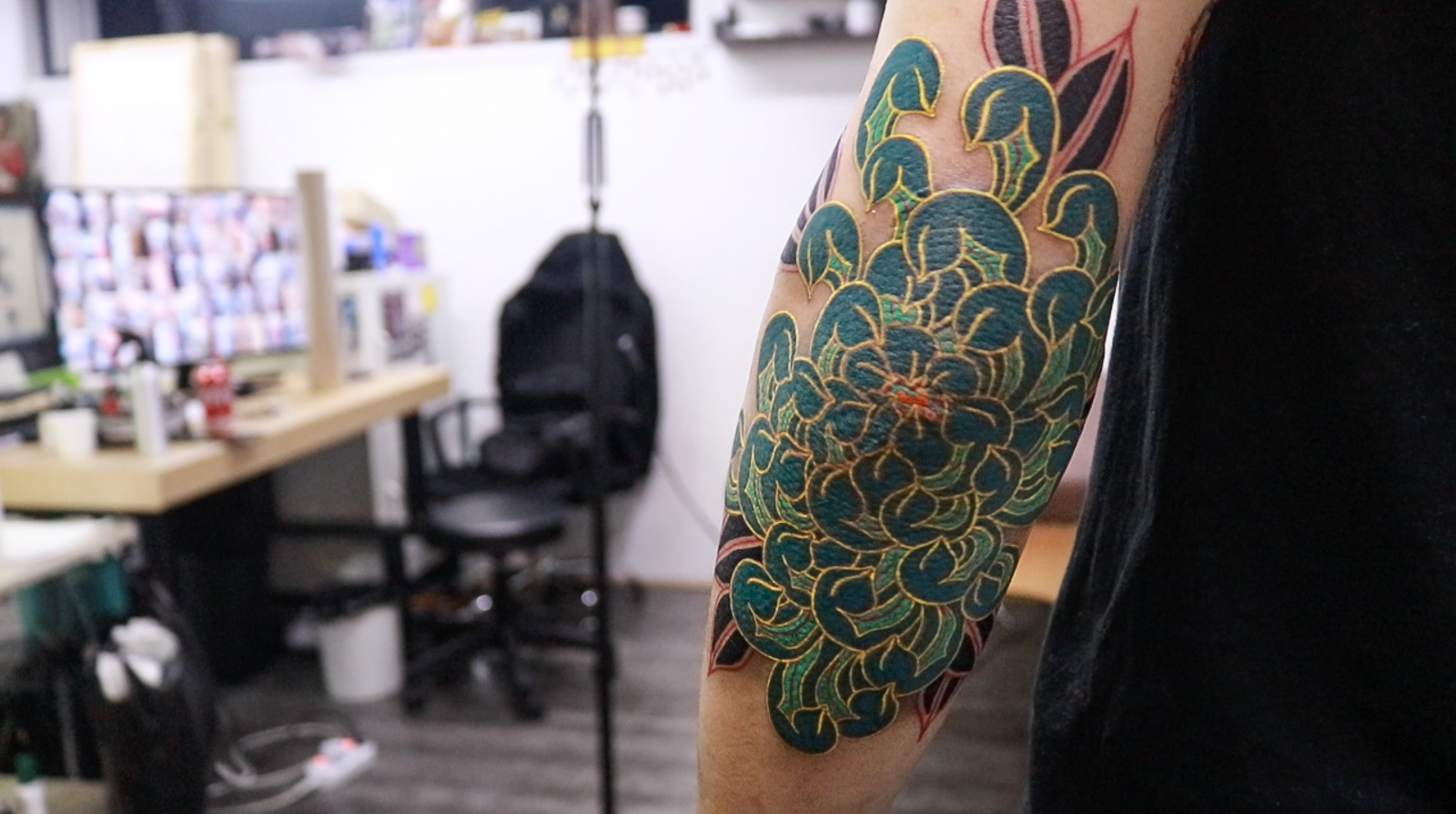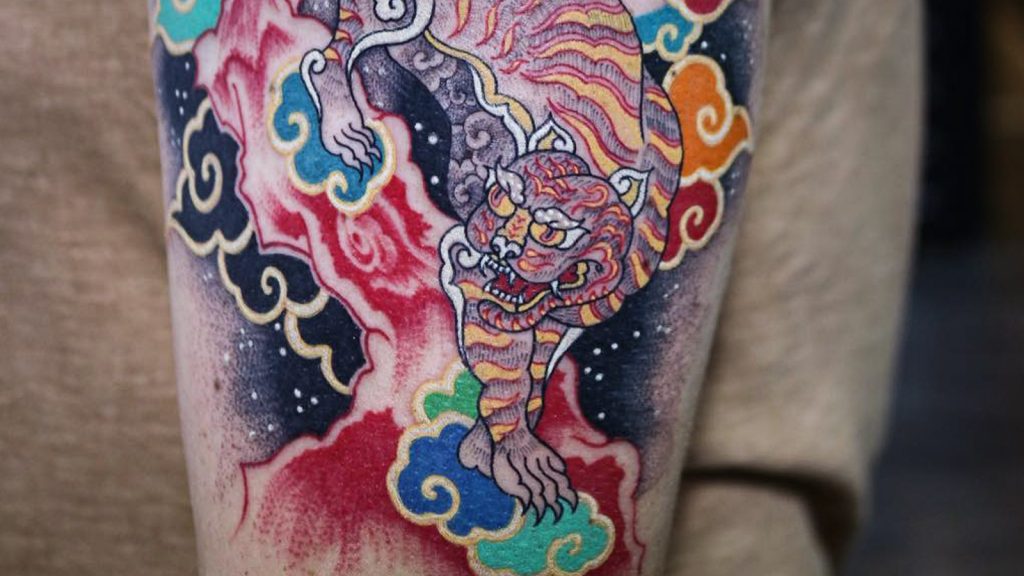SEOUL—Tucked deep within the labyrinth of identical mid-rise residential buildings in the college district of Hongdam is an inconspicuous doorway to what appears to be just another apartment. But behind it is Robin Egg Studio, the secret tattoo parlor run by an artist known as Pitta (or @PittaKKM on social media).
Pitta’s style is a refreshing contemporary take on traditional Korean religious art, reminiscent of the brilliant patterns and motifs that decorate Korean Buddhist temples. His body of work includes fantastical tigers crawling down arms from swirling clouds, dragons slithering around ankles, and lotuses blooming from elbows in a kaleidoscope of traditional Korean colors.
“I’ve just been influenced by my family, because my mother and grandparents are really deep into Buddhism,” said the 25-year-old.
But like a majority of his fellow Seoul-based tattoo artists, Pitta runs his shop illegally.

In South Korea, only licensed doctors are allowed to tattoo people.
“Tattooists in Korea are often punished or imprisoned for violation of the medical law,” said Jun Hyeok Chang, who leads the Korean Tattoo Artist Association, an organization that works to legalize tattooing in Korea. For this reason, Pitta insisted his face and real name remain a secret.
“Most lawmakers are highly conservative and have a negative view of tattooing,” explained Chang. Although the law does not explicitly say that tattooing is illegal, it states that it can only be done by doctors at official medical institutions.
The rapidly growing tattoo scene in Seoul remains underground. Tattoo shops can be found in peculiar places: in basements, seemingly abandoned buildings, or hidden in ordinary residential areas. In this shrouded tattoo world, Pitta is helping to preserve overlooked traditional Korean religious art styles in a nontraditional way.
Pitta’s aesthetic uses a traditional Korean obangsaek, or color scheme, of the “five direction colors.” They represent the five elements of life: water, stone, earth, wood, and fire. “So I use a lot of black, white, yellow, blue, and red,” Pitta explained. “I also use a lot of green from Buddhism.” Green is used in many Korean Buddhist temples to reflect their lush surrounding and evoke scenes from nature.
Obangsaek is ubiquitous in Korean culture, used in Hanbok (traditional attire), Buddhist temples, the national flag, and even bibimbap (a dish with a variety of meats, vegetables, eggs, and rice mixed in a hot stone bowl).
Growing up, Pitta and his family went to the Buddhist temple where his grandfather worked frequently. He spent countless hours paying respect to mountain and tiger deity statues and meditating in front of Korean taenghwa, or Buddhist murals, painted with the vibrantly colored patterns that now inspire much of his tattoo style.

As a sculpture student at Seoul University, Pitta wanted to become a working artist. But after wielding an electric tattoo needle and making his first indelible marks, he was hooked.
“I didn’t think I could do it at the time, but my friend kind of forced me. He got four tattoos a week from me, so my skills grew really fast.” Pitta had already been working on creating a modern version of Buddhist art, but now he was able to translate it onto skin.
Pitta eventually discontinued his studies to become a tattooist full time in spite of the occupation’s hazards. “It’s like living art—when my customer goes somewhere on the other side of the earth some people can recognize my art and tell each other about the tattoos,” said Pitta. “Tattoos can be the connection between really different cultures. I’m proud of my tattooing and my occupation.”
The popularity of Buddhist art in Korea declined when Buddhism was suppressed during the Joseon dynasty (1392–1897). But in the 1970s and ’80s—when South Korea was working to rebuild following the devastation of the Korean War and was finally unmired from decades of Japanese attempts to stifle Korean culture—a renaissance in Korean religious art emerged that has carried on through today.
Many Korean traditional art enthusiasts, such as Robert Turley of the Korean Art Society (KAS) in New York City, believe that keeping the work relevant is key to preserving an integral part of Korean culture.
“You can see traces of Buddhist, Daoist, and shamanistic art in Pitta’s work; it’s more like Korean spiritual art,” said Turley. “This kind of work is important because the native religions affect the attitudes and beliefs of the people.”
“What he’s doing is great,” Turley continued. “He’s really putting on display in the most obvious way these traditional Korean symbols and the traditional Korean aesthetic.”
Through KAS, Turley has sought to promote Korean culture through more formal education and academic means. But he believes Pitta’s ability to garner the attention of a younger and more alternative audience is vital.
Another thing that Turley and Pitta have in common is that their audience is primarily Western.
“More than 90% of my customers are from foreign countries,” Pitta explained while mixing blue and green ink for a lotus tattoo.
Like most tattoo artists in Seoul, his prospective customers reach out to him through Instagram. “Most of my customers want to keep their memory on their skin with my tattoos,” said Pitta.
Pitta’s Taoist clouds, shamanist tigers, and Buddhist dragons can be found imprinted in vibrant obangsaek hues on people all over the world.
“I want to prove that our own legacy works not only in Korea, but worldwide,” Pitta said as he started to etch the blooming lotus on a customer’s elbow.
Thank you for subscribing to Tricycle! As a nonprofit, we depend on readers like you to keep Buddhist teachings and practices widely available.
